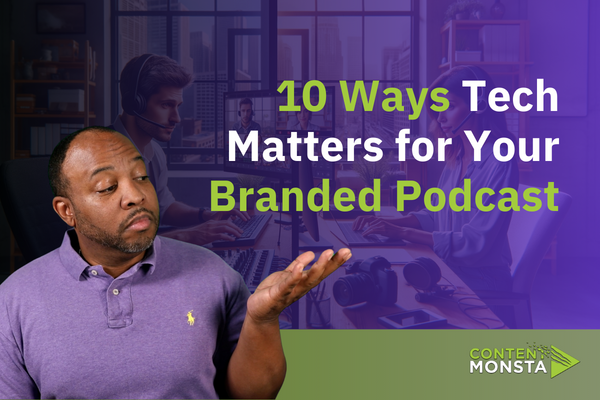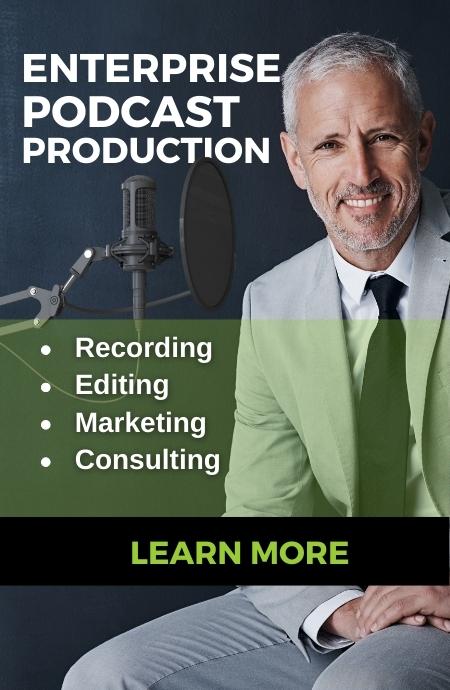When it comes to running a successful B2B podcast, the technical aspects can make or break your audience’s experience, your brand’s image, and ultimately the success of your podcast content initiative.
Whether or not you care about this, your editors and producers should. When these tech considerations are ignored, you can experience friction and reduced value.
But you don’t have to be a tech wizard to elevate your brand’s own show. Here are ten key technical considerations crucial for a thriving podcast and a successful marketing strategy.
Where You Look Is Important
Maintaining a natural and spontaneous flow can foster genuine connections with your audience, creating an engaging and authentic podcast experience. In podcasting, it’s generally recommended to avoid reading from a script or detailed notes, and instead foster an organic conversation using basic outlines or bullet points.
In video, however, if reference to a script or notes is necessary, ensure they are positioned directly in line with the camera lens to maintain as much eye contact with the audience as possible.
As well, looking directly into the camera lens is preferred, instead of where the image of the other participant is positioned on the screen or on an adjacent screen. In the event looking away is unavoidable, it has recently become possible in some circumstances to provide the appearance of eye contact with the viewer – even when the presenter or guest is looking elsewhere – thanks to state of the art post production.
Microphone and Audio Quality
Quality audio not only enhances the listening experience but also contributes to building trust and reliability with your audience, strengthening your brand’s authority. Your microphone can make a massive difference.
While there are many types of microphones, built-in microphones in webcams and laptops are not ideal, and wireless earbuds are worse. A small one-time expense of a professional-grade microphone (usually as little as $150-250) can permit studio-like sound, even at home when in the right environment, and elevates the perception of you and your credibility and professionalism.
Overall audio quality is also important, and paying attention to the quality of background noise and the overall sound of your show matters. Do you recall how you feel when watching a movie or TV show that is not produced very well, even if the story is good? You might not give that as much of a chance because it doesn’t have clear sound. But if you begin with a well produced product, you’re more likely to give it the benefit of the doubt and then be willing to engage and take in its content.
It’s important that you sound at least as good as your guest, or your podcast could backfire. If your guest has a good microphone, and your sound is amateurish in comparison, they sound more credible than you. And, you might come across as if you aren’t as professional. A decent microphone is one-time purchase that can reap rewards over a long period of time. Plus, you can multipurpose that microphone for guest appearances on other podcast or online events, your own video calls, and for recording your own videos.
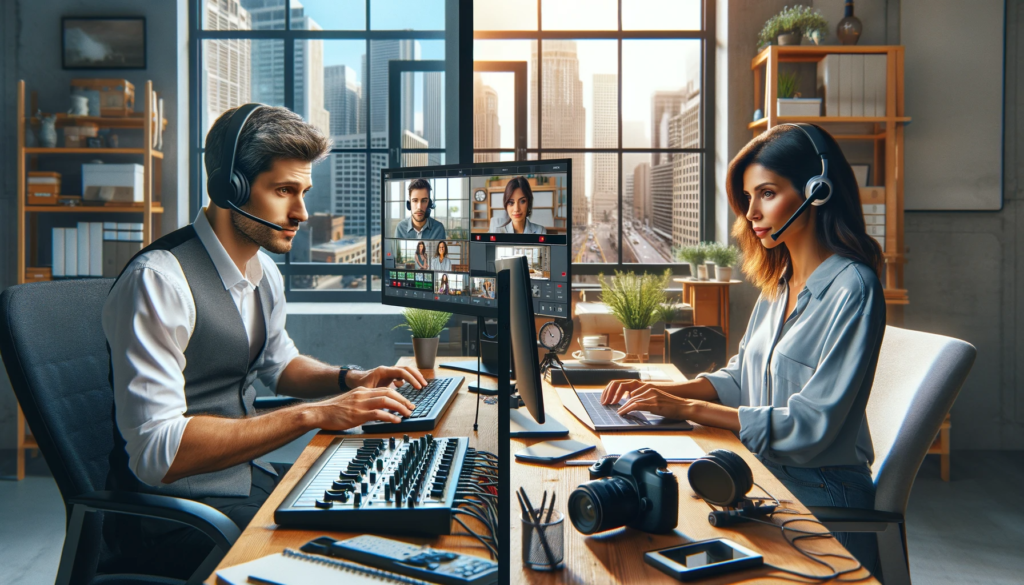
Ambient Audio Advantage
While you will want to eliminate undesirable background sounds, like voices, the lawnmower outside, air conditioners, etc., in the right moments strategic management of ambient noise can actually add a sense of authenticity and relatability to your podcast, building a deeper connection with your audience.
If you are recording in a live environment, such as from the floor of a trade show, conference or sporting event, for example, the background sounds can bring authenticity and a sense of “you are there” to the conversation, elevating credibility. Even the sound of a busy office may give you additional credibility that you are in the midst of busy and successful activity instead of in some sort of artificial studio.
Therefore, it is not necessary in all circumstances to eliminate background noise. Instead, be conscious of what noises are good and what noises are not. In the editing process, the usual noise reduction process should not necessarily be applied, as it could suppress the valuable background sounds.
Thoughtful Music Selection
Music can serve as a powerful tool to convey the podcast’s tone and message. The right music can create an emotional resonance that enhances the overall listening experience and reinforces the brand’s identity.
Whether it is theme music, or music used to transition between segments, some people are inclined to select music because they like the song, their friend wrote it, or they are a fan of the artist or musical style. While that’s not always “wrong”, how a music selection reflects a company or personal brand and aligns with the target audience also matters. Certain musical types might not connect well with a certain audience.
For example, a lively show may not match with slow-paced, classical music. A poor music choice puts the audience in the wrong frame of mind, and it takes a while for them to shake that assumption of what they thought the show was going to be.
Also, while a popular song may be exciting, that doesn’t mean you can or should use it. Be sure that your music has been properly licensed for use. And, even if you can use a popular song and can afford to license it, that tune may not mean the same thing to every member of your audience as it does to you, and will distract from your otherwise-valuable content. It’s best to use licensed, royalty-free music that aligns well with your brand and the show’s ethos.
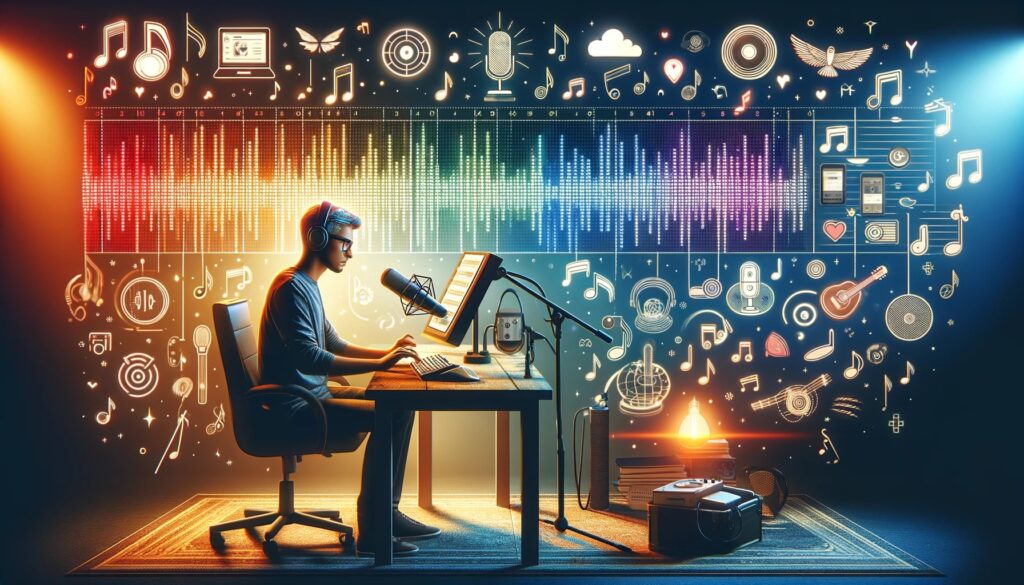
Environmental Control
Creating a clean and well-curated recording environment communicates a sense of professionalism and credibility, as well as enhances the visual appeal, contributing to the overall brand perception. If you are recording video, this means attention to both audio and video.
Be conscious about the environment you’re recording in. Are you in a busy office? Do you have your door open? Is there background noise that you can control, such as an air conditioner? Can you ask your landscaper to come on a different day or at a different time, so sound from their equipment doesn’t impede your audio quality?
Background Check
If you’re on video, exactly what is in the background? Appearing on camera in front of a window that shows people passing by and looking at what you’re doing might be a distraction to your audience (or even you), reducing your credibility and pulling attention away from your message.
As well, when creating video content, everything seen in the background means something to the audience. A collection of empty liquor bottles has one message. A pile of awards and trophies tells a different story. Another company’s branding in the background may not align well with your company or sponsor’s priorities, even if it has personal meaning to you. Be aware of photos in the background that will no longer be private.
Each of these things says something about who you and your brand are. Avoid unintentionally shifting your audience’s attention away from your message and instead to the background visuals that tell a different story.
Video Quality
When recording video content, opting for high-quality cameras and maintaining a consistent background setting can significantly enhance the podcast’s visual appeal. Delivering a visually engaging and professional podcast that resonates with the audience reflects your brand’s commitment to excellence.
First, as basic as it seems, assuring your lens is clean can be an image-quality deal breaker. So are having a solid Internet bandwidth when recording remotely, and using the right kind of recording platform. Preferred platforms can deliver HD audio and video recordings, while other platforms intended primarily for video calling may be limited to compressed (lower quality) raw recordings which are further degraded by the time you end up with the final edited file.
Starting with a high quality HD camera with sufficient pixel resolution is very important. Just by using a webcam capable of at least 1080p and HD video, and using one made by a known name brand, you already have a fairer chance at good video. Most cameras built into your laptop are not as good as most external high quality web cameras, which are very affordable. When producing a high-end video podcast for a business, it’s easily worth the modest investment for a higher and more professional grade camera.
Your podcast viewer notices the difference, which reflects significantly on your brand. Consider what else you put out into the world as a brand – what you wear to an important meeting, how much care has gone into designing your book or materials for your company, and the care that has gone into your overall branding. Shouldn’t the same opportunity be afforded to your video podcast? Everything that can be seen and heard from your brand should look and sound as good as possible.

Editing with Care
Attention to detail during post-production ensures that the podcast maintains a high standard of quality, contributing to a seamless and engaging podcast experience for the audience.
The final file generated after editing must be at a certain level of quality. Otherwise, additional compression may reduce the listening experience, with the episode sounding muddy and even difficult to hear. Imagine a blockbuster movie that was shot with a vintage camcorder from the 1980s instead of today’s state-of-the-art technology!
The post-production process is important as well. Edits must be carefully made without being sloppy, and overall audio mastering assures sound levels are at industry standards and that the audio file sounds professionally clear, crisp, and easy to understand. With the tools available today, both AI and those requiring the hands of a skilled editor, quality sound and well-edited content should be an expected baseline.
Strategic Show Notes and Episode Titles
Optimizing show notes and titles for search engine discoverability and audience engagement plays a crucial role in maximizing the podcast’s reach and impact, effectively promoting the podcast’s content and enhancing its accessibility to a wider audience.
The show notes, or description of the episode, offer the audience a chance to preview the episode content and decide to consume it. Perhaps more importantly, the show notes drive SEO and discovery. Proper care into the content and format of show notes, assuring they conform to industry standards, and designing them so they promote your brand’s messaging priorities, are all mission-critical.
The same care must be taken in selecting each episode title. Cute titles can be fun, but they may not help with SEO maximization. Best practices: include the main topic or theme of the episode in a concise manner without ambiguity, incorporate relevant keywords commonly used by your target audience, use compelling, action-oriented words or questions that pique curiosity, maintain a consistent format for your episode titles, and include details such as guest names, special segments, or exclusive content.

Quality Control at Every Stage
Strong oversight and meticulous attention to detail ensure that every aspect of the podcast meets industry standards and reflects the brand’s commitment to delivering a worthy podcast experience for the audience.
Having a project management resource, a specific process flow for each aspect of production, and production resources and partners in place, will reinforce confidence in your ability to efficiently and consistently produce content with a proper level of quality and value,
By prioritizing technical considerations and incorporating the insights from the original text, your B2B podcast can be noticed and effectively communicate your brand’s message with clarity and professionalism. You can create engagement and meaningful connections with your audience and amplify your brand as a leading authority in your industry.

The QvQ Content Funnel: Ending the Quality versus Quantity Question
Marketers often debate whether to prioritize the quality or quantity of content. The QvQ Content Funnel proposes a strategy to balance both, tailoring content type and volume to different sales funnel stages. This method enhances engagement, drives conversions, and builds customer loyalty by delivering the right content at the right time.

5 Digital Marketing Content Types That Drive Business
There are several digital marketing content types that are sure to drive business over the coming years. It’s no secret that content marketing is the driving force behind most, if
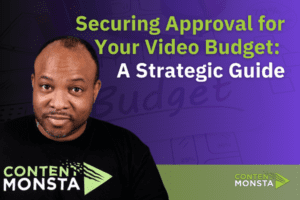
Marketing Video Budget – How to secure executive approval
Discover how to secure executive approval for your video marketing budget. This article teaches you to address the critical concerns of CFOs and CMOs, focusing on efficiency, cost-effectiveness, and ROI. Learn strategies for promoting quick turnarounds, diversifying video content, and implementing remote production. Equip yourself with the tools to present a strategic, results-oriented plan that aligns with your company’s goals and impresses your executives.

